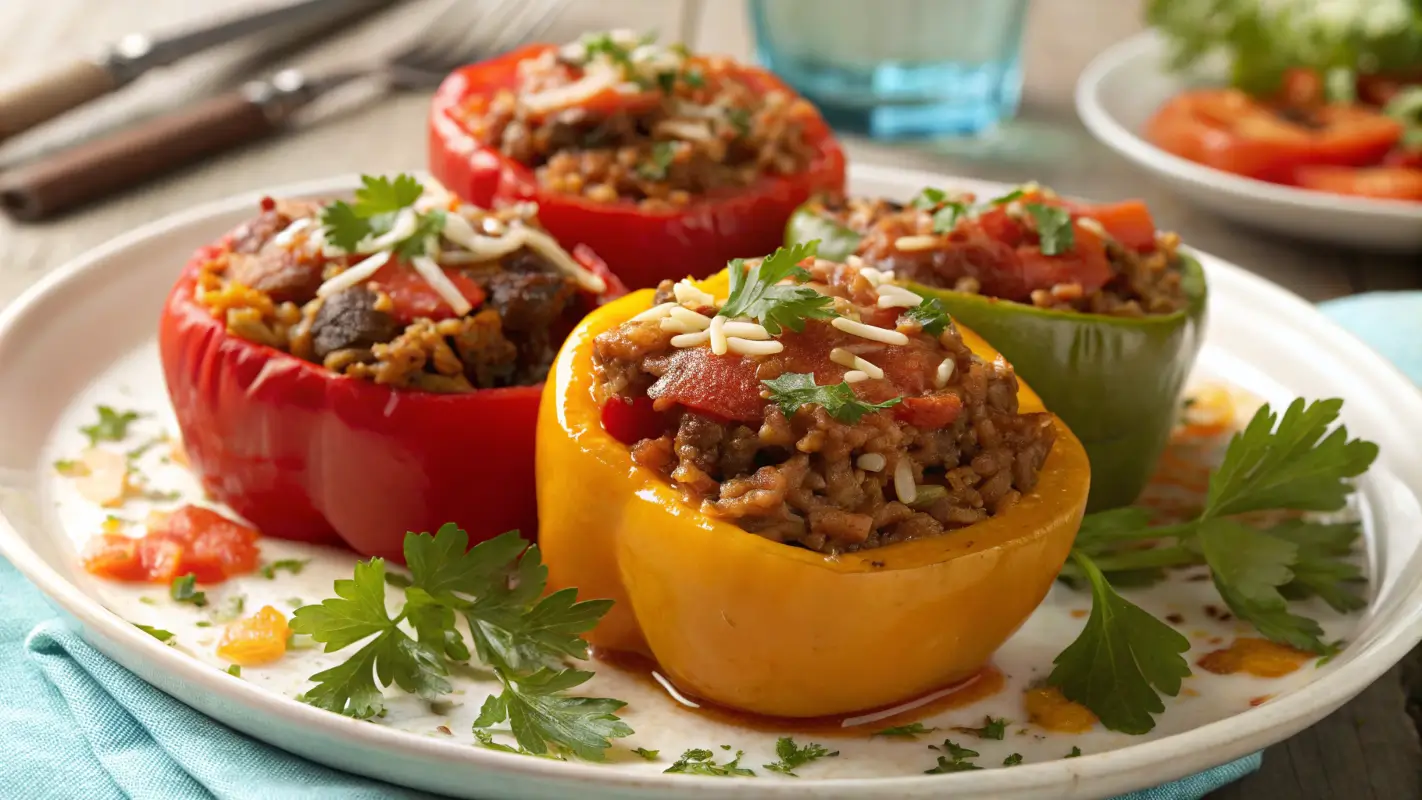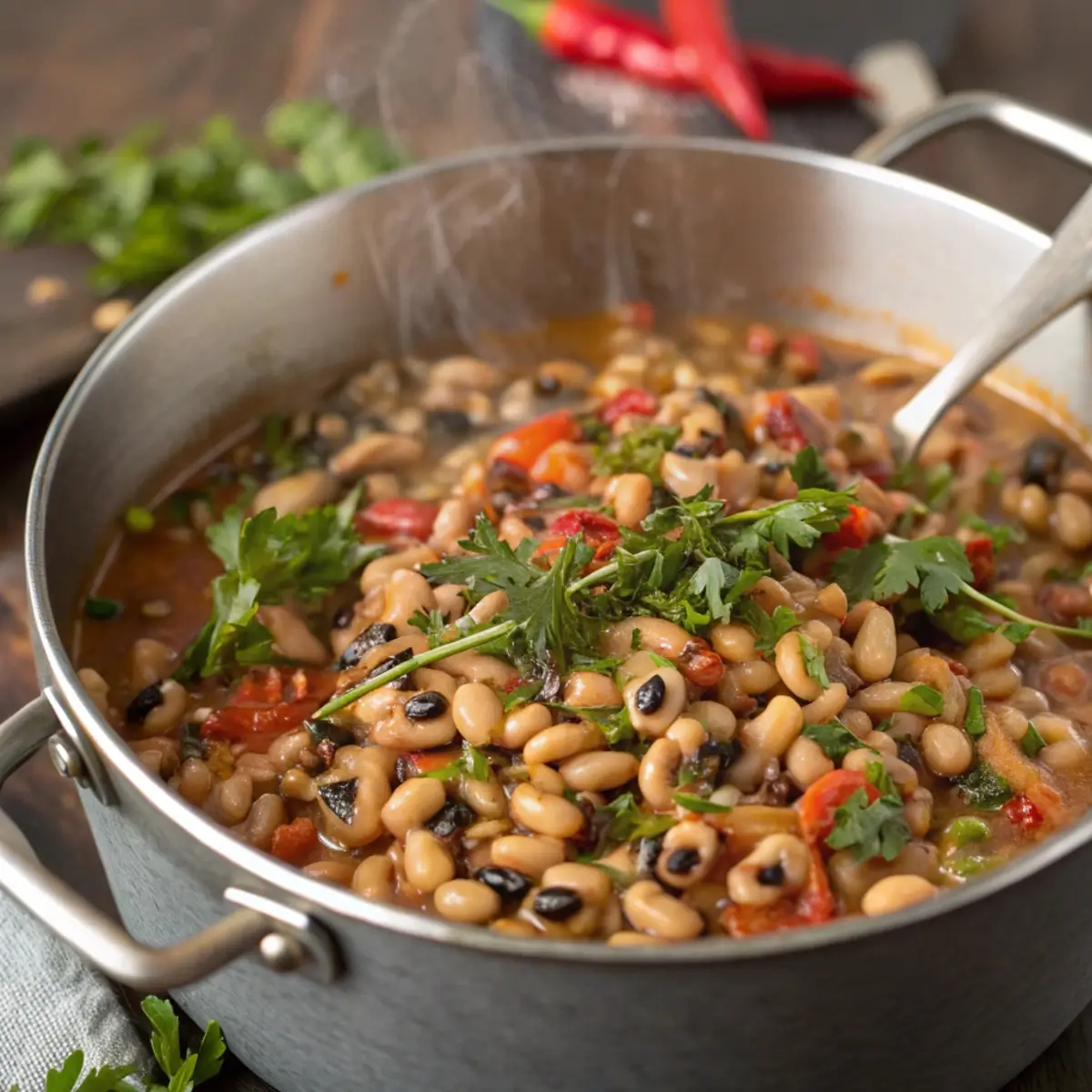Table of Contents
- 1 Introduction to Stuffed Bell Peppers
- 2 The Ingredients for Old Fashioned Stuffed Bell Peppers Recipe
- 3 Step-by-Step Instructions for Making Stuffed Bell Peppers Recipe
- 4 Tips for Perfect Stuffed Bell Peppers
- 5 Nutritional Information and Health Benefits
- 6 Creative Variations of Stuffed Bell Peppers
- 7 How to Make Stuffed Bell Peppers Ahead of Time
- 8 Pairing Stuffed Bell Peppers with Side Dishes
- 9 Frequently Asked Questions About Stuffed Bell Peppers
Introduction to Stuffed Bell Peppers
When you think of a hearty, comforting meal, stuffed bell peppers might just come to mind. This classic dish has been passed down through generations, loved for its simplicity, versatility, and comforting flavors. Whether you’re looking for a cozy dinner to warm you up or a meal that’s easy to prepare for the whole family, old fashioned stuffed bell peppers recipe fit the bill perfectly.
In this article, we’ll dive into the world of stuffed bell peppers. From the traditional ingredients to creative variations, we’ll explore everything you need to know to make the best stuffed bell peppers in your kitchen. We’ll take you step-by-step through the recipe, offer tips for getting the peppers just right, and even suggest healthier alternatives to suit any dietary need.
Stuffed bell peppers are so much more than just a dish—they’re a nostalgic reminder of home-cooked meals, rich in flavors and family memories. Now, let’s get started and discover the beauty of this classic recipe!
The Ingredients for Old Fashioned Stuffed Bell Peppers Recipe
Bell Peppers: The Base of the Dish
When it comes to stuffed bell peppers, the bell pepper is the star. These colorful vegetables are more than just eye-catching—they are the perfect vessel for holding all of the flavorful ingredients inside. Whether you choose vibrant red, yellow, orange, or the classic green, the flavor of your stuffed peppers can vary slightly depending on the type of pepper used. Green bell peppers offer a more earthy, slightly bitter flavor, while red and yellow peppers are milder and sweeter.
It’s essential to choose fresh, firm peppers for your dish. Look for peppers with no blemishes or soft spots. They should have a sturdy base that allows them to stand upright, providing a stable platform for your filling.
The Meat Filling
A traditional old fashioned stuffed bell peppers recipe calls for ground beef. The savory richness of beef works beautifully with the natural sweetness of the peppers. However, you don’t have to stick to beef—you can easily substitute it with other proteins depending on your preferences:
- Ground turkey or chicken: Leaner alternatives that work wonderfully in place of beef. These options keep the dish lighter while still providing a hearty filling.
- Vegetarian options: If you prefer a meatless version, consider using cooked lentils, quinoa, or even black beans to create a filling that’s just as satisfying. These plant-based options are packed with protein and fiber.
Whichever protein you choose, make sure to cook it thoroughly and season it generously with herbs and spices for the best flavor.
Rice as a Binder
Rice is one of the most essential ingredients in stuffed bell peppers. It acts as a binder, holding all the filling together and providing a satisfying texture. While white rice is the most common choice, you can easily switch it up based on dietary preferences:
- White rice: The classic option, fluffy and easy to prepare.
- Brown rice: A more fiber-rich alternative that gives the dish a nuttier flavor.
- Cauliflower rice: A fantastic low-carb alternative that’s perfect for keto or gluten-free diets.
While rice is the go-to choice, feel free to get creative. Quinoa or couscous can add more texture, and both are packed with nutrients.
The Tomato Sauce
No stuffed bell peppers recipe would be complete without a rich, tangy tomato sauce. The sauce not only adds flavor but also helps cook the peppers while keeping the filling moist and tender. For convenience, you can use store-bought tomato sauce, but if you want to elevate the dish, try making your own with fresh tomatoes, garlic, and herbs.
- Store-bought tomato sauce: Fast and easy, perfect for busy weeknights.
- Homemade tomato sauce: If you have the time, making your own tomato sauce is a great way to add layers of flavor. Add basil, oregano, or garlic to enhance the taste.
Additionally, some people like to sprinkle cheese on top or even mix it into the filling for an extra creamy, cheesy finish.
Step-by-Step Instructions for Making Stuffed Bell Peppers Recipe
Preparing the Bell Peppers
The first step in making your stuffed bell peppers is preparing the peppers themselves. Start by cutting off the tops of the peppers and carefully removing the seeds and membranes from inside. A sharp knife will help make this process easier.
You may choose to blanch the peppers briefly in boiling water for about 5 minutes, which will help soften them and make them easier to eat. If you prefer a firmer pepper with more bite, you can skip this step and cook them as is.
Once prepared, set the peppers aside while you get started on the filling.
Preparing the Stuffing
Now comes the fun part: making the stuffing! Begin by browning your choice of ground meat (or a plant-based alternative) in a large skillet. Add finely chopped onions, garlic, and any other vegetables you want to include, such as bell pepper scraps or mushrooms. Cook everything until it’s tender and fragrant.
Next, stir in your cooked rice (or alternative grain), followed by your tomato sauce. Season the mixture with herbs like oregano, basil, or thyme. Salt and pepper to taste, and be sure to add a little bit of crushed red pepper if you want a bit of heat.
For extra flavor, you can also add a handful of cheese to the mixture, allowing it to melt into the filling. This step gives your stuffed peppers a rich, cheesy interior. Once your filling is well-combined and flavorful, you’re ready to stuff the peppers.
Assembling the Stuffed Peppers
Now that your filling is ready, it’s time to stuff the peppers! Carefully spoon the filling into each bell pepper, pressing down gently to pack the stuffing in. Be sure to fill them to the top but don’t overstuff them, as the filling will expand during cooking.
Once the peppers are stuffed, place them in a baking dish, standing upright. Pour your tomato sauce over the stuffed peppers, covering them generously. You can also add a bit of water or broth to the bottom of the baking dish to help keep the peppers moist as they bake.
Cover the baking dish with aluminum foil and bake the peppers at 375°F (190°C) for about 30-40 minutes, until the peppers are tender and the filling is heated through. For a golden, bubbly top, remove the foil in the last 10 minutes of cooking.
Tips for Perfect Stuffed Bell Peppers
How to Keep the Peppers Tender
One common concern when making stuffed bell peppers is ensuring that the peppers stay tender without becoming mushy. The key is to avoid overcooking them. If you’re using large peppers, consider blanching them for a few minutes before stuffing them, as this will help them soften more quickly in the oven.
Another tip is to bake the peppers covered with foil for most of the cooking time. This traps moisture, ensuring the peppers cook evenly and don’t dry out. Removing the foil toward the end allows the filling to brown and the top to become deliciously crispy.
Flavor Enhancements
If you want to take your stuffed bell peppers to the next level, here are a few ideas:
- Add cheese: Whether you mix it into the filling or sprinkle it on top, cheese adds creaminess and extra flavor. Mozzarella, cheddar, or parmesan all work well.
- Spice it up: If you like a little heat, add chopped jalapeños or a dash of hot sauce to your filling. The sweetness of the peppers pairs beautifully with a bit of spice.
- Herb it up: Fresh herbs like parsley, cilantro, or thyme can really brighten up the dish and add depth to the flavor.
Using Leftovers and Variations
Stuffed bell peppers can be easily adapted for leftovers. If you have extra filling, try using it for a delicious casserole or even as a topping for baked potatoes. You can also make stuffed peppers in advance and bake them later, which makes for an easy meal prep option.
For variations, consider switching up the protein, using quinoa or couscous in place of rice, or adding extra vegetables like corn or spinach to the filling.
Nutritional Information and Health Benefits
Nutritional Breakdown
Stuffed bell peppers can be a well-balanced meal, providing a good mix of protein, fiber, and vitamins. Here’s a quick look at the typical nutritional breakdown for a serving of stuffed peppers (based on a recipe with ground beef, rice, and tomato sauce):
- Calories: 250-350 per serving (depending on the ingredients and portion size)
- Protein: 20-25 grams
- Fat: 10-15 grams
- Carbs: 25-30 grams
- Fiber: 4-6 grams
This makes stuffed bell peppers a great option for anyone looking for a filling and nutritious meal.
Healthier Alternatives
While the classic stuffed bell peppers recipe is delicious, you can make a few adjustments to make it even healthier:
- Use lean ground turkey or chicken instead of beef for a lower-fat option.
- Switch to brown rice or quinoa for added fiber and nutrients.
- Add more vegetables to the filling for extra vitamins and minerals—spinach, mushrooms, or zucchini work well.
Benefits of Bell Peppers
Bell peppers are not only tasty but also packed with nutrients. They’re an excellent source of vitamins A and C, both of which are vital for immune health and skin protection. Bell peppers are also rich in antioxidants, which help fight inflammation and promote overall well-being.
Plus, they’re low in calories and high in fiber, making them a great choice for anyone trying to maintain a healthy diet.
Discover more about bell pepper varieties and their health benefits.
Creative Variations of Stuffed Bell Peppers
Vegetarian Stuffed Bell Peppers
For those who prefer a meatless meal, vegetarian stuffed bell peppers are just as satisfying and full of flavor. Instead of the traditional ground beef or turkey, you can create a hearty filling using a variety of plant-based ingredients.
-
Lentils: Cooked lentils make a perfect base for vegetarian stuffed peppers. They are rich in protein and fiber, providing a meaty texture without the meat. Mix cooked lentils with tomato sauce, onions, garlic, and your favorite spices for a flavorful filling.
-
Quinoa: Another great option, quinoa is a complete protein and pairs wonderfully with bell peppers. Add sautéed vegetables like mushrooms, zucchini, and spinach to the quinoa for a delicious veggie-packed filling.
-
Beans: Black beans, kidney beans, or chickpeas make fantastic alternatives in vegetarian stuffed peppers. Combine them with rice, corn, tomatoes, and a mix of spices for a Mediterranean-inspired version.
Mediterranean Stuffed Bell Peppers
Take your stuffed bell peppers in a new direction by embracing Mediterranean flavors. Here’s how:
-
Filling: Use a mix of cooked quinoa, crumbled feta cheese, Kalamata olives, and diced cucumbers. Add fresh herbs like parsley, mint, and oregano to enhance the Mediterranean flavors.
-
Seasoning: Instead of the typical tomato sauce, try using a blend of olive oil, lemon juice, and garlic. This will give your peppers a bright and tangy flavor.
This variation is light, healthy, and bursting with flavor—perfect for a summer meal or a fresh twist on a classic.
Taco-Inspired Stuffed Peppers
If you’re a fan of Mexican flavors, taco-inspired stuffed bell peppers are a must-try. Simply swap the usual ground beef for taco-seasoned ground beef, turkey, or chicken, and add the following ingredients:
- Black beans and corn for a hearty and filling base.
- Shredded cheese like cheddar or Monterey Jack for extra flavor.
- Sour cream and salsa as toppings to finish off the dish.
Top with a few fresh cilantro leaves for an authentic taco flair. This variation is sure to be a hit at dinner time!
How to Make Stuffed Bell Peppers Ahead of Time
Make-Ahead Tips for Busy Weekdays
One of the best things about stuffed bell peppers is that they can easily be made ahead of time, making them perfect for busy nights when you don’t want to spend hours in the kitchen.
-
Prepare the filling in advance: You can prepare the stuffing a day or two ahead of time and store it in the fridge. This gives the flavors time to meld together, making the filling even more flavorful.
-
Stuff the peppers: Once the filling is prepared, stuff the bell peppers and arrange them in a baking dish. Cover the dish with plastic wrap or foil and store it in the fridge for up to 24 hours before baking.
-
Freezer-friendly: Stuffed peppers can also be frozen for later use. Simply assemble the stuffed peppers, but don’t bake them. Instead, wrap them tightly in plastic wrap or foil and place them in a freezer-safe container. When you’re ready to cook them, bake straight from the freezer—just add a few extra minutes to the cooking time.
Reheating Leftovers
If you have leftover stuffed bell peppers, don’t worry—they reheat wonderfully! Here’s how to bring them back to life:
-
Oven: Preheat your oven to 350°F (175°C). Place the stuffed peppers in an oven-safe dish, cover with foil, and bake for about 20 minutes until heated through.
-
Microwave: For a quick reheat, pop the stuffed peppers in the microwave for 3-5 minutes, depending on your microwave’s wattage.
Reheating stuffed peppers keeps them flavorful and moist, so you can enjoy this dish for multiple meals!
Pairing Stuffed Bell Peppers with Side Dishes
Perfect Side Dishes for Stuffed Bell Peppers
While stuffed bell peppers are a meal in themselves, they pair wonderfully with various sides to complete your dinner. Here are a few side dish ideas:
-
Garlic Bread: A classic side that pairs well with almost any meal, garlic bread is perfect for soaking up the extra tomato sauce. You can make it from scratch or use store-bought bread for convenience.
-
Roasted Vegetables: A light, healthy side of roasted vegetables like carrots, zucchini, and potatoes can balance the richness of the stuffed peppers. Simply toss them with olive oil and your favorite seasonings, and roast at 400°F (200°C) until tender.
-
Garden Salad: A crisp, fresh salad is an excellent side to complement the savory flavors of the stuffed peppers. Try a simple salad with mixed greens, cucumber, tomato, and a light vinaigrette.
-
Rice Pilaf: If you’re a rice lover, serve your stuffed peppers with a flavorful rice pilaf on the side. The grains and seasoning will pair beautifully with the savory filling inside the peppers.
Drink Pairings
When it comes to drinks, stuffed bell peppers go well with a variety of beverages:
- Sparkling water: Light and refreshing, sparkling water with a squeeze of lemon is a great non-alcoholic pairing.
- Iced tea: If you’re looking for a slightly sweet, refreshing drink, iced tea pairs well with the hearty flavors of stuffed peppers.
- Fruit juices: A tart fruit juice like cranberry or pomegranate adds a burst of freshness alongside the savory stuffed peppers.
Frequently Asked Questions About Stuffed Bell Peppers
Can I use different types of peppers for stuffed bell peppers?
Yes! While bell peppers are the classic choice, you can experiment with other types of peppers such as poblano peppers or Anaheim peppers. These peppers are larger and can hold more stuffing, and they have a slightly different flavor profile.
Can I freeze stuffed bell peppers?
Absolutely! Stuffed bell peppers can be frozen before or after baking. If you freeze them before cooking, simply bake them from frozen, adding about 10 minutes to the cooking time. If you’ve already baked them, let them cool before wrapping and freezing for up to 3 months.
How can I make stuffed bell peppers spicy?
If you like a little heat, try adding chopped jalapeños or serrano peppers to your filling. You can also add a pinch of cayenne pepper or a dash of hot sauce to the stuffing for that spicy kick.
How long do stuffed bell peppers last in the fridge?
Stuffed bell peppers can be stored in the fridge for up to 3 days. Make sure to store them in an airtight container to maintain their freshness.
Can I make stuffed bell peppers in a slow cooker?
Yes! Stuffed bell peppers can be cooked in a slow cooker. Simply place the stuffed peppers in the slow cooker, cover with tomato sauce, and cook on low for 4-6 hours until the peppers are tender.





